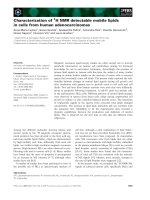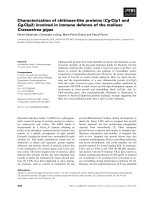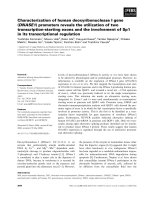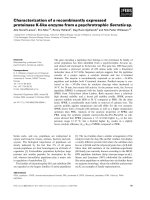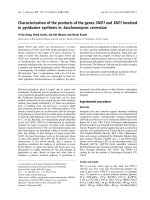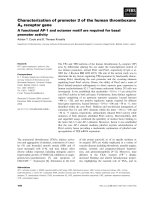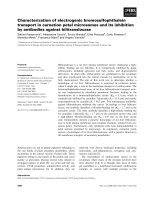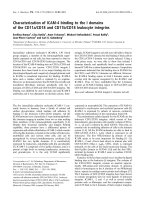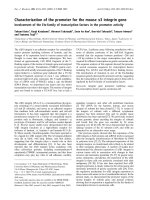Báo cáo khóa học: Characterization of Mesorhizobium huakuii lipid A containing both D-galacturonic acid and phosphate residues ppt
Bạn đang xem bản rút gọn của tài liệu. Xem và tải ngay bản đầy đủ của tài liệu tại đây (826.11 KB, 13 trang )
Characterization of
Mesorhizobium huakuii
lipid A containing both
D
-galacturonic acid and phosphate residues
Adam Choma
1
and Pawel Sowinski
2
1
Department of General Microbiology, Maria Curie-Sklodowska University, Lublin, Poland;
2
Intercollegiate NMR Laboratory,
Department of Chemistry, Technical University of Gdansk, Poland
The chemical structure of the free lipid A isolated from
Mesorhizobium huakuii IFO 15243
T
was elucidated. Lipid A
is a mixture of at least six species of molecules whose struc-
tures differ both in the phosphorylation of sugar backbone
and in fatty acylation. The backbone consists of a b (1¢fi 6)
linked 2,3-diamino-2,3-dideoxyglucose (DAG) disaccharide
that is partly substituted by phosphate at position 4¢.The
aglycon of the DAG-disaccharide has been identified as
a-
D
-galacturonic acid. All lipid A species carry four amide-
linked 3-hydroxyl fatty residues. Two of them have short
hydrocarbon chains (i.e. 3-OH-i-13:0) while the other two
have longer ones (i.e. 3-OH-20:0). Distribution of 3-hydroxyl
fatty acids between the reducing and nonreducing DAG is
symmetrical. The nonpolar as well as (x-1) hydroxyl long
chain fatty acids are components of acyloxyacyl moieties.
Two acyloxyacyl residues occur exclusively in the non-
reducing moiety of the sugar backbone but their distribution
has not been established yet. The distal DAG amide-bound
fatty acid hydroxyls are not stoichiometrically substituted
by ester-linked acyl components.
Keywords: Mesorhizobium huakuii; lipid A; 2,3-diamino-
2,3-dideoxy-
D
-glucose; MALDI-TOF; 2D-NMR.
Lipopolysaccharides (LPS) are characteristic components of
the outer leaflet of the outer membranes of Gram-negative
bacteria. Those glycoconjugates have a common general
architecture. They contain three distinct regions: lipid A, a
nonrepeating oligosaccharide core and an O-polysaccharide
composed of a varying number of repeating units. The
O-polysaccharide chain is the major target of animal
immune responses, thus it is also referred to as the
O-antigen. The core oligosaccharide is a spacer between
the O-chain and lipid A and is linked to the latter by an acid
labile ketosidic bond. Lipids A in many Gram-negative
bacteria (especially in animal pathogens) have a conserved
structure. In the majority of cases, their backbones are
composed of a b-1,6-
D
-glucosamine disaccharide with two
phosphate residues attached at positions 1 and 4¢.Upto
four fatty acids are bound by ester or amide linkages
to the backbone glucosamines. Lipid A is responsible for the
endotoxic properties of lipopolysaccharide. The structure of
lipid A seems to be essential in maintaining outer membrane
integrity and flexibility and is crucial for bacterial cell
viability [1–3].
Lipopolysaccharide is important in the process of sym-
biotic interaction between Rhizobium and the host plant
[4,5]. Environmental conditions (in planta and ex planta)as
well as plant-derived molecular signals induce entire LPS
modifications in Rhizobium [6].
The structures of Rhizobium lipid A indicate great
variation in the glycosyl component of its backbone as well
as the acylation pattern. The lipid A backbone of Sinorhizo-
bium is similar to that from enteric bacteria [7,8]. Lipids A
from Rhizobium etli and biovars of Rhizobium legumino-
sarum have identical and unusual structures. R. etli lipids A
are devoid of phosphate groups [9–11] and a galacturonic
acid residue replaces the 4¢-linked phosphate in the lipid A
backbone. The distal part (distant from the reducing end of
the backbone) of lipid A is almost the same for all lipid A
species isolated. The proximal glucosamine is partly oxi-
dized to 2-aminogluconate [12,13]. A specific deacylase
removes the ester-linked fatty acids from the C-3 position
of the lipid A precursor, thus this hydroxyl is only partially
substituted by an acyl residue in the matured lipid A [14].
The symbiont of Sesbasnia, Rhizobium sp. Sin-1 [15],
has lipid A composed of b-
D
-glucosamine attached to
2-aminogluconate by (1fi 6) glycoside linkage. When
compared with R. etli this lipid A lacks galacturonic acid
at position 4¢ [16].
In contrast to the above mentioned lipid A structures, the
mesorhizobial and bradyrhizobial lipids A have not been
fully chemically characterized to date. Bradyrhizobium
lipid A backbones are composed exclusively of 2,3-di-
amino-2,3-dideoxyglucose with mannose as a subsituent in
some of them [4,5,17,18]. No data about Allorhizobium
(renamed Rhizobium undicola [19]) and scant information
about Azorhizobium [20,21] lipopolysaccharides and lipids A
are available. Mesorhizobium loti lipids A contain DAG
and phosphate residues [22,23] and M. huakuii also posses-
ses DAG-type lipid A [24]. Mesorhizobium lipids A are
known to carry a number of b-hydroxyl fatty acids
accompanied by small amounts of 4-oxo fatty acids.
Correspondence to A. Choma, Department of General Microbiology,
Maria Curie-Sklodowska University, 19 Akademicka St.,
20–033 Lublin, Poland.
Fax: + 48 81 5375959, Tel.: + 48 81 5375981,
E-mail:
Abbreviations: DAG, 2,3-diamino-2,3-dideoxyglucose; LPS,
lipopolysaccharides.
(Received 12 September 2003, revised 6 February 2004,
accepted 16 February 2004)
Eur. J. Biochem. 271, 1310–1322 (2004) Ó FEBS 2004 doi:10.1111/j.1432-1033.2004.04038.x
Numerous ester-linked nonpolar and (x-1) hydroxyl long
chain fatty residues were found in those preparations [25,26].
In this report, we describe the structural investigation of a
unique lipid A isolated from Mesorhizobium huakuii. We
show that DAG-type lipid A backbone is double decorated:
(a) nonstoichiometrically, with phosphate at position 4¢ of
thedistalDAG,and(b)witha-linked galacturonic acid
at position 1 of the proximal unit. Phosphorylated and
nonphosphorylated lipid A preparations are a mixture of
three subfractions differing in acylation patterns.
Experimental procedures
Bacterial strain, growth, and isolation of
lipopolysaccharide and lipid A
Mesorhizobium huakuii IFO15243
T
strain was obtained
from the Institute for Fermentation, Osaka, Japan. Bacteria
were grown at 28 °C in liquid mannitol/yeast extract
medium 79CA [27] and were aerated by vigorous shaking.
Cells were centrifuged at 10 000 g, washed twice with saline
and once with distilled water. The wet bacterial paste was
extracted by the modified hot phenol/water procedure [28].
The water layer was dialysed firstly against tap water, then
against distilled water. The crude LPS was purified by
repeated ultracentrifugation at 105 000 g for 4 h. The LPS
solution (5 mgÆmL
)1
) in aqueous 1% (v/v) acetic acid was
kept at 100 °C for 3 h. The lipid A precipitate was collected
by centrifugation, washed twice with hot distilled water and
lyophilized.
Purification and separation of lipid A species
Crude lipid A was purified and separated into subfractions
according to a modified procedure described by Que and
coworkers [9]. Briefly, lyophilized lipid A ( 30 mg) was
dissolvedin20mLofCHCl
3
/methanol/H
2
O (2:3:1;
v/v/v) and loaded onto a DEAE column (1 cm · 7cm,
Whatman DE23). The column was washed with 30 mL of
the same solvent and that eluate was collected as a single
fraction. Next, the lipid material was eluted by a two step
gradient of ammonium acetate: first with 30 mL of CHCl
3
/
methanol/250 m
M
NH
4
Ac (2 : 3 : 1; v/v/v), and then with
30 mL of CHCl
3
/CH
3
OH/500 m
M
NH
4
Ac (2 : 3 : 1;
v/v/v). The presence of organic substances in the eluate
was monitored by spotting 10 lL of each fraction on a silica
plate and visualized by spraying the plate with 10% (v/v)
sulfuric acid in methanol followed by charring. Separated
fractions were converted to two-phase Bligh–Dyer system
by adding the appropriate amount of water and chloroform.
Water layers were discarded and organic layers were
supplemented with fresh portions of the upper phase of
a freshly prepared two-phase Bligh–Dyer mixture. The
washed organic layers were separated by centrifugation and
dried. Preparations were stored at )20 °CinCHCl
3
/
methanol (1 : 1; v/v).
Glycosyl composition analysis
Lipid A samples were analysed for fatty acids and amino-
sugars as described previously [24]. Neutral and acidic
sugars were determined by gas-liquid chromatography and
mass spectrometry. For this analysis, lipid A samples were
methanolysed (1
M
HCl, 80 °C, 18 h), N-acetylated and
trimethylsililated [29]. The content of phosphorus in lipid A
was determined according to Lowry [30].
Chemical modification of lipid A
Subfractions of lipid A (about 2 mg) were dephosphory-
lated in 48% (v/v) aqueous HF at 4 °C for 48 h [31]. HF was
removed by evaporation in the stream of nitrogen with
cooling in an ice bath. De-O-acylation of lipid A subfractions
was performed according to modified procedure of Haishima
and coworkers [31]. Preparations were treated with anhy-
drous hydrazine at 37 °C for 2 h. The reaction mixtures, after
cooling, were poured into cold acetone. The resulting lipid A
precipitates were collected, washed twice with acetone and
then gently dried in the stream of nitrogen.
Gas chromatography-mass spectrometry
GC-MS was carried out on a Hewlett-Packard gas
chromatograph (model HP5890A) equipped with a capil-
lary column (HP-5MS, 30 m · 0.25 mm) and connected to
a mass selective detector (MSD model HP 5971). Helium
was the carrier gas. The temperature program for fatty acid
methyl esters and for alditol acetates analysis was as follows:
initially 150 °Cfor5min,thenraisedto310°Cataramp
rate of 3 °Cmin
)1
, final time 20 min. The temperature
program for trimethylsililo derivatives of methyl glycosides
was, accordingly: initially 80 °C for 2 min, then raised to
310 °Cataramprateof4°Cmin
)1
, final time 5 min.
Mass spectrometry
Matrix-assisted laser desorption ionization-time of flight
(MALDI-TOF) mass spectrometry was performed on a
Voyager-Elite (PE Biosystems) instrument using delayed
extraction, in both positive and negative ion modes. The
samples were desorbed with a nitrogen laser and extraction
voltage of 20 kV. Lipid A samples were dissolved in CHCl
3
/
CH
3
OH (2 : 1; v/v). The analysed compounds (0.5 lL)
were mixed with 50% (v/v) 2,5-dihydrobenzoic acid in
acetonitril as matrix. Each spectrum was the average of
about 256 laser shots.
Liquid matrix-assisted secondary ion mass spectrometry
(LSIMS) was performed using AMD 604 (AMD Intectra
GmbH) mass spectrometer operated in the negative ion
mode with primary ion beam of Cs
+
.Samplesweremixed
with a matrix of meta-nitrobenzyl alcohol (m-NBA).
Lipid A was analysed by ESI-MS using Finnigan Mat
TSQ 700 mass spectrometer operated in the negative ion
mode. The samples were dissolved in a CHCl
3
/CH
3
OH
(2 : 1; v/v) mixture supplemented with 0.1% (v/v) concen-
trated ammonia and introduced into electrospray source
at a flow rate of 5 lLÆmin
)1
.
NMR spectroscopy
1
H-NMR experiments were performed in CDCl
3
/dimethyl-
sulfoxide-d
6
(2 : 1; v/v) mixture. 2D (DQF COSY, TOCSY,
NOESY)
1
H-NMR and
1
H/
13
Caswellas
1
H/
31
P-HSQC
experiments were carried out on Varian Unity plus 500
Ó FEBS 2004 Structure of Mesorhizobium huakuii lipid A (Eur. J. Biochem. 271) 1311
instrument at 48 °C using standard
VARIAN
software. 1D
31
P-NMR spectra were registered on a Bruker 300 spectro-
meter, operating at 121.58 MHz at 40 °C. For this analysis,
the lipid A was dissolved in D
2
O containing 2% deoxycho-
late and 5 m
M
Na
2
EDTA. The pH of lipid A solutions was
adjusted with NaOH to 7.3 and 10.6, respectively. Phospho-
rous chemical shifts were measured relative to an external
standard of 85% (v/v) phosphoric acid at 0.00 p.p.m.
Results
Chemical analyses
The compositional analysis of crude lipid A preparation
obtained from M. huakuii IFO 15243
T
LPS revealed the
presence not only of 2,3-diamino-2,3-dideoxyglucose
(DAG) and a complex set of fatty acids (both ester and
amide bound), as described previously [24], but also
galacturonic acid and phosphate residues. The presence of
GalA was unequivocally confirmed by GC-MS analysis of
trimethylsilil ethers of methyl glycosides liberated from
lipid A by methanolysis (Fig. 1). The
31
P-NMR spectrum
of the crude lipid A revealed a prominent signal with
chemical shift of 1.71 p.p.m. observed at neutral pH. This
signal was shifted to 4.71 p.p.m. when the pH of the lipid A
suspension was raised to 10.6 (Fig. 2). These properties are
indicative of phosphomonoesters other than glycosyl-
1-phosphate. The location of the phosphate was directly
determined by two-dimensional heteronuclear magnetic
resonance (see below). On the basis of chemical shift value
and lack of the cross peak with protons from the lipid A
backbone on the
31
P/
1
H-HSQC spectrum, the weak signal
at 1.88 p.p.m. was attributed to inorganic phosphate
impurities of the lipid A preparation. The results of
quantitative measurements of phosphorus and DAG con-
tent showed that no more than half of the lipid A molecules
bear phosphate residues.
Fatty acids found in the IFO 15243
T
lipid A (Fig. 1) can
be divided into two groups. The first one, easily liberated by
mild alkali or acid solvolysis, contains all saturated and
unsaturated nonpolar as well as (x-1) hydroxyl, and (x-1)
oxo long chain fatty acids. These are ester-linked to the
lipid A. The second group of fatty acids needs strong
liberation conditions [32]. This group comprises all
3-hydroxyl and 4-oxo fatty acids, which are connected
directly to the lipid A backbone via amino groups [24]. The
molar proportions among fatty acids isolated from lipid A
were almost the same as described earlier for the total LPS
[24]. The main amide-bound fatty acids identified were as
follows: 3-OH-12:0, 3-OH-i-13:0, 3-OH-20:0 and 3-OH-
21:0.Amongthem,3-OH-i-13:0 and 3-OH-20:0 clearly
predominated. The types of ester-bound fatty acids were
also numerous, but only four of them, namely i-17:0, 20:0,
22:1 and particularly 27-OH-28:0 fatty acid, predomi-
nated (Fig. 1, [24]). The calculated proportion between
Fig. 1. GC-MS profile of trimethylsilyl ether derivatives of N-acetylated methyl glycosides and fatty acid methyl esters obtained by methanolysis of
dephosphorylated lipid A from Mesorhizobium huakuii IFO 15243
T
. Peaks were identified by their mass spectra and by comparison of retention times
with standards. GalA, galacturonic acid; DAG, 2,3-diamino-2,3-dideoxyglucose; p.e. impurity-ester of phtalic acid; *, unidentified compound. For
more details about the fatty acid composition of IFO 15243
T
see [24].
Fig. 2.
31
P-NMR spectra of the crude lipid A from Mesorhizobium
huakuii IFO 15243
T
. The signal at 1.71 p.p.m. (A) recorded at pH 7.3,
shifted to 4.71 p.p.m. (B) at pH 10.60, and represents ester-bound
monophosphate residue.
1312 A. Choma and P. Sowinski (Eur. J. Biochem. 271) Ó FEBS 2004
amide- and ester-linked fatty acids was approximately 2 : 1.
Therefore, one can expect that DAG type lipid A could
contain not more than six acyl residues.
The complex mixture of the lipid A preparation was
separated into two fractions, based on DEAE gravity
column chromatography. The first fraction (designated
lipid A
–P
), which was eluted with solvent containing
250 m
M
ammonium acetate, was devoid of phosphate, as
shown by
31
P-NMR. The phosphate was detected in
the second fraction (named lipid A
+P
), successively eluted
with a solvent mixture containing 500 m
M
NH
4
Ac.
MALDI-TOF analysis of lipid A preparations
Both subfractions of lipid A were investigated by mass
spectrometry. Ions representative of each species of lipid A,
recorded on the negative and positive ion MALDI-TOF
and negative ion ES-MS spectra, their corresponding
composition and the theoretically calculated masses are
listed in Table 1.
Lipid A
+P
is a complex mixture of individual molecules.
The two major species (Z and Y) could be easily
distinguished from mononegatively charged pseudomole-
cular ions on MALDI-TOF spectrum (Fig. 3A). The third
(X) cluster of ions, which were less intensive, was visible
between m/z at 1600 and 1700. All those ions correspond to
lipid A that posseses a backbone with a monophosphate
residue accompanied by six, five and four acyl moieties,
respectively. Dephosphorylation procedure, to which
lipid A
+P
was submitted, led to a downshift of each
molecular ion by 80 mass units. The spectrum of the
dephosphorylated lipid A
+P
is almost identical to that
obtained for the lipid A
–P
preparation (Fig. 4). Moreover,
the MALDI-TOF spectrum of lipid A
–P
treated with 48%
HF did not change significantly when compared with the
unprocessed preparation (data not shown).
Species Z of lipid A
+P
(Fig. 3A) contained ions within the
range from 2287 to 2478 mass units. Those ions correspond
to lipid A molecules composed of two DAG, one of which
is phosphorylated, one GalA, four 3-hydroxyl fatty acids,
one (x-1) hydroxyl long chain fatty acid and one a nonpolar
fatty acyl residue. The most intense ion in this cluster (m/z
at 2357) could be attributed to the molecules of lipid A
containing two 3-OH-i-13:0 and two 3-OH-20:0 acids, as
well as two ester-bound acids (e.g. 20:0 and 27-OH-28:0).
This is merely one possible explanation due to the fact that
numerous combinations of fatty acids different to those
found in lipid A exist. However, taking into consideration
the quantities of lipid A fatty acids this proposition seems
to be the most probable. The amide-bound fatty acids
isolated from M. huakuii IFO15243
T
lipid A and from
other mesorhizobia can be separated into two clusters
[24–26]. The first contains short chain fatty acids, mainly
3-OH-12:0 and 3-OH-i-13:0, whereas the second is repre-
sented by 3-OH-20:0 and other fatty acids similar in length.
For correct calculation of the pseudomolecular ion masses
found on the MALDI-TOF spectra it is necessary to take
into account the masses of two 3-OH short chain fatty
acyls (e.g. 3-OH-i-13:0) and two longer 3-OH fatty acyl
residues (e.g. 3-OH-20:0).
The ions from species Y are usually 295 mass units
lighter than the respective ions from species Z. That
corresponds to a loss of eicosanoyl residue from hexaacyl
lipid A. Therefore, the Y species comprise ions represent-
ing lipid A molecules carrying five acyl residues (four
3-OH fatty acids and one (x-1) hydroxyl long chain fatty
acid). The ion at m/z 1640 and those close to m/z 1640,
designated as species X, correspond to tetraacyl lipid A
molecules with all acyl residues directly linked to the sugar
backbone by amide bonds. De-O-acylation of lipid A
fractionsledtodecayofspeciesZandYandresultedin
increase of signals corresponding to ions of species X
(data not shown). The total decrease of mass due to de-O-
acylation of phosphorylated as well as of nonphospho-
rylated lipid A was the same and equalled 717 Da (loss of
both 294 and 423 mass units).
The positive ion MALDI-TOF mass spectra of the
lipid A
+P
(Fig. 3B) showed two additional species gener-
ated after laser-induced cleavage of glycosidic linkages
between 2,3-diamino-2,3-dideoxyglucoses within the lipid
A backbone. The first species [B
1
+
(Z)
] of oxonium ions
originated from hexaacyl phosphorylated lipid A (pro-
minent ions at m/z 1481 and 1508). The second species
[B
1
+
(Y)
] consist of ions with masses close to that at m/z
1187. Those ions are made up of DAG, two 3-hydroxyl
fatty acyl moieties and (x-1) hydroxyl long chain fatty
acid. Those B
1
+
fragment ions support the conclusion that
the 27-hydroxyoctacosanoic acid and eicosanoic acid,
when present, are located on the distal diaminoglucosyl
residue of the lipid A. Moreover, the sugar component of
B
1
+
lacks hydroxyl groups suitable for attachment of
these fatty acids by ester bonds. The appropriate hydroxyls
are located at positions 3 of amide linked acyl of the distal
DAG. Therefore, both 27-OH-28:0 and 20:0 fatty acids are
components of acyloxyacyl residues. The predicted ions for
the third type of oxonium ions composed of DAG and
two amide acyl residues have not been registered, due to
the fact that the spectra were usually recorded from m/z
1000–3000. The correct calculation of masses for B
1
+
type
ions requires taking into account the appropriate amide-
linked fatty acids. That group of acyl residues consists of
fatty acid pairs. The first acid in each pair is shorter (e.g.
3-OH-i-13:0) while the second one is longer (e.g. 3-OH-
20:0). Analysis of lipid A by means of LSI mass spectro-
metry revealed negative ions m/z at 862.7, 876.8 and 890.7
(data not shown). The most intensive ion (m/z at 876.8)
corresponds to a lipid A fragment composed of DAG,
GalA, 3-OH-i-13:0 and 3-OH-20:0. A similar ion was
observed for P. gingivalis and F. meningosepticum lipids A
on negative ion FAB-MS/MS spectra [33,34]. In conclu-
sion, these data point to the symmetrical localization of
amide-bound acyl residues in M. huakuii lipid A. The
2,3-diacylamido-2,3-dideoxyglucose, obtained by mild
solvolysis [35] followed by mild hydrolysis of the dephos-
phorylated lipid A, was reduced with NaBD
4
,than
subjected to Smith oxidation, again reduced with NaBH
4
and after acetylation, the four-carbon fragments of DAG
carrying amide-bound fatty acids were analysed by means
of GC-MS. Preliminary data from those experiments
indicate that N-2 position in distal and proximal DAG is
occupied mainly by 3-hydroxyleicosanoic acids. The shor-
ter acids were found to be bound at N-3 position of the
amino sugar ring. The fatty acid distribution will be
verified during further studies.
Ó FEBS 2004 Structure of Mesorhizobium huakuii lipid A (Eur. J. Biochem. 271) 1313
Table 1. Data from mass spectrometry analyses. Positive and negative ions derived from phosphorylated and nonphosphrylated lipid A fractions of Mesorhizobium huakuii IFO 1243
T
; their compositions and
proposed structures. Backbone*, trisaccharide of b-
D
-DAG-(1 fi 6)-a-
D
-DAG-(1fi1)-a-
D
-GalA; P, phosphate residue; nd, not determined.
Positive mode MS Negative mode MS Composition
MALDI-TOF
(ion type and
m/z-value)
MALDI-TOF
(ion type and
m/z-value)
ES-MS
(ion type
m/z-value)
molecular mass
calculated from
ES-MS value
DAG P GalA
3-OH-
fatty
acids
(x-1)-OH
-fatty
acids
Nonpolar
fatty
acids
Total number
of fatty acid
carbon atoms
Proposed
composition
of the molecule
Predicted
molecular
mass
Phosphorylated lipid A fraction
[M + Na]
+
2380
[M-H]
–
2357
[M-2H]
)2
1177.9
2357.8 2 1 1 4 1 1 114 Backbone*, phosphate,
2 · 3-OH-20:0,
2 · 3-OH-i-13:0,
27-OH-28:0, 20:0
2357.398
[M + Na]
+
2085
[M-H]
–
2063
[M-2H]
)2
1030.7
2063.4 2 1 1 4 1 0 94 Backbone, phosphate,
2 · 3-OH-20:0,
2 · 3-OH-i-13:0,
27-OH-28:0
2062.875
[M + Na]
+
1663
[M-H]
–
1640
[M-2H]
)2
nd
– 2 1 1 4 0 0 66 Backbone, phosphate,
2 · 3-OH-20:0,
2 · 3-OH-i-13:0
1640.137
B
1
+
1481
– – – 1 1 1 2 1 1 81 P-DAG,
1 · 3-OH-20:0,
1 · 3-OH-i-13:0,
27-OH-28:0, 20:0
1481.276
B
1
+
1187
– – – 1 1 1 2 1 0 61 P-DAG,
1 · 3-OH-20:0,
1 · 3-OH-i-13:0,
27-OH-28:0
1186.753
Unphosphorylated lipid A fraction
[M + Na]
+
2299
– – – 2 0 1 4 1 1 114 Backbone,
2 · 3-OH-20:0,
2 · 3-OH-i-13:0,
27-OH-28:0, 20:0
2277.419
[M + Na]
+
2004
– – – 2 0 1 4 1 0 94 Backbone,
2 · 3-OH-20:0,
2 · 3-OH-i-13:0,
27-OH-28:0, 20:0
1982.896
B
1
+
1400
– – – 1 0 1 2 1 1 81 DAG
2 · 3-OH-20:0,
2 · 3-OH-i-13:0,
27-OH-28:0, 20:0
1401.297
B
1
+
1108
– – – 1 0 1 2 1 0 61 DAG
2 · 3-OH-20:0,
2 · 3-OH-i-13:0,
27-OH-28:0
1106.774
1314 A. Choma and P. Sowinski (Eur. J. Biochem. 271) Ó FEBS 2004
The B
1
+
ions from lipid A
+P
(e.g. m/z at 1187 and 1508,
Fig. 3B) differed by 80 mass units from those originating
from lipid A
–P
(e.g. m/z at 1108 and 1428, Fig. 4).
Comparing Figs 3B and 4, it is easy to notice that
the phosphate deprived lipid A appears to have a higher
number of connected fatty acids. On the spectrum,
shown in Fig. 4, the signals for hexaacyl lipid A are
considerably more intensive than others. Pentaacyl
lipid A molecules dominate in the case of the phos-
phorylated lipid A preparation. Possibly, a weak acid
hydrolysis (the procedure used for lipid A liberation)
causes a partial de-O-acylation of the native lipid A
molecules.
In contrast to R. etli, R. leguminosarum and S. melilotii
[8–10], we did not find lipid A molecules containing
3-hydroxylbutyrate or 3-metoxylbutyrate.
Fig. 3. Negative (A) and positive (B) ion MALDI-TOF mass spectra of the phosphorylated subfraction of lipid A from M. huakuii IFO 15243
T
.
Lipid A yields three ion clusters (Z, Y, X). They differ by the degree of acylation. Species X contains four amide-bound fatty acids. Species Y is
pentaacyl lipid A (with 27-OH-28:0 fatty acid residue). Species Z is hexaacyl lipid A. The proposed formulas and masses of pseudomolecular ions
([M ) H]
–
and [M + Na]
+
) are summarized in Table 1. The individual ions in the clusters differ by 14 units (acyl chain length differences). Positive
ion spectrum contains two B
+
1
type ion clusters derived from cleavage of the glycosidic linkage in lipid A. Unidentified ions are marked with
asterisks (*).
Ó FEBS 2004 Structure of Mesorhizobium huakuii lipid A (Eur. J. Biochem. 271) 1315
NMR spectroscopy of lipid A preparations
De-O-acylated lipids A
+P
and lipid A
–P
were dissolved in a
mixture of dimethylsulfoxide (DMSO-d
6
)andchloroform
(CDCl
3
) for NMR experiments. Figure 5 shows the one-
dimentional proton spectrum of de-O-acylated lipids A
+P
.
1
Hand
13
C chemical shift assignments were based on 2D
homonuclear experiments: DQF-COSY (Fig. 6), TOCSY
(Fig. 7) and
1
H/
13
C heteronuclear single quantum coher-
ence (HSQC) experiments. The values of carbon and proton
chemical shifts are summarized in Table 2.
Three signals were identified in the anomeric region of
13
C-NMR chemical shifts for both lipid A fractions. These
data suggested that the lipid A backbone contains three
sugar residues. Four signals were found between 50 and
55 p.p.m. for each preparation. They were assigned to the
C-2 and C-3 carbon atoms linked directly with the amino
groups. The remaining sugar ring carbon signals were
observed in the region from 60 to 78 p.p.m. TOCSY and
DQF-COSY spectra revealed three glycosyl ring systems.
The anomeric proton (H
A
-1) at 4.98 p.p.m. was assigned to
a-linked galacturonic residue. Its spin system (A) consists of
five protons for which all the cross peaks have been traced
andmarkedonFig.6andresultingchemicalshiftslistedin
Table 2. Analysis of the sugar proton system B (Fig. 7) was
initiated at the anomeric proton (H
B
-1, d
H
¼ 4.87 p.p.m.,
J
1,2
¼ 2.8Hz). That proton showed an evident correlation
to H
B
-2 (d
H
¼ 3.84 p.p.m.), which showed a strong corre-
lation to H
B
-3 (d
H
¼ 4.08 p.p.m.). Furthermore, H
B
-3
showed a coupling with H
B
-4 (d
H
¼ 3.48 p.p.m.). The
remaining glycosyl proton cross-peaks were observed at
following chemical shifts: 3.48 p.p.m./3.97 p.p.m. (H
B
-4/
H
B
-5), 3.97 p.p.m./3.60 p.p.m. (H
B
-5/H
B
-6a), 3.60 p.p.m./
3.89 p.p.m. (H
B
-6a/H
B
-6b). The proton chemical shifts for
both sugar ring systems (A and B) were similar to those
published for A. pyrophilus lipid A [36]. Chemical shifts of
the distal aminosugar (sugar ring system C) in lipid A
+P
were in good agreement with those from A. pyrophilus
lipid A distal DAG, however, two shift exceptions (for H
C
-4
and H
C
-3) were observed. The H
C
-4 signal appeared at
Fig. 5. Proton NMR spectrum of de-O-acylated lipids A
+P
fraction. The sample was dissolved in DMSO-d
6
/CDCl
3
(1 : 2, v/v). The spectrum was
recorded at 500 MHz, at 48 °C. Some signals from sugar backbone are indicated. The letters refer to the carbohydrate spin systems as was described
in the text and shown in Table 2. The numerals next to the letters indicate the protons in the respective residues. Signal positions from olefinic
protons, terminal methyl protons, bulk methylene protons and protons from a, b and c positions of 3-hydroxy fatty acids are marked with;
-CH ¼ CH-, -CH
3
,and-CH
2
-, a, b and c, respectively. CHCl
3
,DMSOandH
2
O represent signals from solvents and absorbed water.
Fig. 4. Positive ion MALDI-TOF mass spectrum of unphosphorylated subfraction of lipid A from M. huakuii IFO 15243
T
. This lipid A subfraction
yields the three ion clusters X1, Y1 and Z1. They differ in the degree of acylation pattern and contain four, five and six acyl residues, respectively.
The spectrum contains two B
+
1
type ion clusters derived by cleavage of the glycosidic linkage in lipid A.
1316 A. Choma and P. Sowinski (Eur. J. Biochem. 271) Ó FEBS 2004
d
H
¼ 4.01 p.p.m., which was about 0.3 p.p.m. downfield
from the A. pyrophilus lipid A equivalent signal and about
0.5 p.p.m. downfield from the H-4 signal characteristic of
DAG with unsubstituted hydroxyl group at C-4 carbon
atom (d
H
for H
B
-4, Table 2). The downfield shift of H
C
-4
was caused by the presence of ester-bound phosphate
residue. Analysis of carbon chemical shifts led to the same
conclusions, since C
C
-4 (d
C
¼ 71.9 p.p.m) appeared down-
field compared to the proximal C
B
-4 unsubstituted by
phosphate (d
B
¼ 67.5 p.p.m). The location of phosphate
substituent on C
C
-4 was established upon H
C
-4/
31
P
(4.01 p.p.m./1.35 p.p.m) correlation observed in
1
H/
31
P
HSQC spectrum.
The sequence of the monosaccharides was established
by NOESY experiment (Fig. 8). A strong interresidue
NOE signal was observed between H
A
-1 of GalA and
Fig. 6. A partial DQF-COSY spectrum of de-O-acylated phosphorylated subfraction of lipid A. The spectrum was recorded at 500 MHz, at 48 °C.
The letters refer to the carbohydrate spin systems as was described in the text and shown in Table 2. The numerals next to the letters indicate the
protons in the respective residues.
Fig. 7. A partial TOCSY spectrum of de-O-acylated phosphorylated subfraction of lipid A. The spectrum was recorded at 500 MHz, at 48 °C. The
letters refer to the carbohydrate spin systems as was described in the text and shown in Table 2. The numerals next to the letters indicate the protons
in the respective residues.
Ó FEBS 2004 Structure of Mesorhizobium huakuii lipid A (Eur. J. Biochem. 271) 1317
Table 2. 1H- and 13C-NMR chemical shifts and coupling constants of sugar backbones of lipid A fractions. DAG-I proximal 2,3-diamino-2,3-
dideoxyglucose moiety in the lipid A from M. huakuii IFO 15243
T
, DAG-II distal 2,3-diamino-2,3-dideoxyglucose moiety in the lipid A from
M. huakuii IFO 15243
T
; lipid A
+P
, phosphorylated fraction of lipid A; lipid A
–P
, unphosphorylated lipid A; nd, not determined; J, coupling
constant. Spectra were recorded at 500 MHz (
1
H) and 125.7 MHz (
13
C) in DMSO-d
6
/CDCl
3
(2 : 1, v/v).
Residue
(spin system)
DAG-II (C) DAG-I (B) GalA (A)
1
H d (J,[Hz])
13
C d
1
H d (J,[Hz])
13
C d
1
H d (J,[Hz])
13
C d
Lipid A
+P
H-1 4.39
(8.2)
C-1 103.1 H-1 4.87
(2.8)
C-1 92.8 H-1 4.98
(2.8)
C-1 94.9
H-2 3.72 C-2 54.5 H-2 3.84 C-2 52.0 H-2 3.78 C-2 67.9
H-3 3.94 C-3 54.7 H-3 4.08 C-3 51.3 H-3 3.94 C-3 68.8
H-4 4.01 C-4 71.9 H-4 3.48 C-4 67.5 H-4 4.08 C-4 70.8
H-5 3.23 C-5 77.8 H-5 3.97 C-5 71.8 H-5 4.42 C-5 71.1
H-6a 3.53 C-6 60.8 H-6a 3.60 C-6 68.7 C-6 nd
H-6b 3.79 H-6b 3.89
NH-2 7.23 NH-2 7.26
NH-3 7.26 NH-3 7.24
Lipid A
–P
H-1 4.35
( 8)
C-1 102.8 H-1 4.89
( 2)
C-1 92.4 H-1 5.02
( 3)
C-1 94.5
H-2 3.73 C-2 53.8 H-2 3.86 C-2 52.0 H-2 3.78 C-2 68.2
H-3 3.77 C-3 53.8 H-3 4.13 C-3 51.7 H-3 3.95 C-3 71.7
H-4 3.34 C-4 68.8 H-4 3.52 C-4 70.3 H-4 4.12 C-4 70.5
H-5 3.22 C-5 nd H-5 3.93 C-5 71.8 H-5 4.42 C-5 71.0
H-6a 3.58 C-6 61.4 H-6a 3.62 C-6 68.8 C-6 nd
H-6b 3.71 H-6b 3.93
NH-2 7.46 NH-2 7.42
NH-3 7.38 NH-3 7.41
Fig. 8. A partial NOESY spectrum of de-
O-acylated phosphorylated subfraction of
lipid A. The spectrum was recorded at
500 MHz and at 48 °C. The letters refer to the
carbohydrate spin systems as was described in
the text and shown in Table 2. The numerals
next to the letters indicate the protons in the
respective residues. The inter- and intraresidue
signals are labeled starting from anomeric
protons. Diagnostic interresidue cross peaks
are underlined.
1318 A. Choma and P. Sowinski (Eur. J. Biochem. 271) Ó FEBS 2004
H
B
-1 of the proximal DAG. Both sugars possess a
anomeric configurations that are reflected in the small
values of J
1,2
coupling constants and the appropriate
values of chemical shifts. The downfield shift of carbon
C
B
-6 from the proximal DAG and strong cross peak
H
C
-1/H
B
-6a (4.39 p.p.m./3.60 p.p.m), as well as less
intensive cross peak at 4.39 p.p.m./3.89 p.p.m. (H
C
-1/
H
B
-6b) on NOESY spectrum, unequivocally indicate the
presence of (1fi 6) glycosidic linkage between the two
DAG residues. Chemical shifts: C
C
-1 (103.1 p.p.m), H
C
-1
(4.39 p.p.m) and large ( 8Hz) coupling constants J
1,2
measured for the distal DAG confirmed its b-anomeric
configuration.
Putting all the presented data together, we propose the
chemical structures for lipid A
+P
(species Z, Y, X) as shown
in Fig. 9.
Fig. 9. Tentative structures of lipid A species from Mesorhizobium huakuii IFO 12543
T
. The proposition of the positions of 3-hydroxyl acyls is based
on preliminary chemical degradation of lipid A. The predicted positions of ester bound fatty acids were elicited from literature data and specificity
of LpxXl acyltransferase [46]. The proposed structures corresponds to [M + Na]
+
ions at m/z 2380 (Z), 2085 (Y), 1663 (X) in Fig. 2B and to ions at
m/z 2299 (Z1), 2004 (Y1), 1583(X1) in Fig. 3B.
Ó FEBS 2004 Structure of Mesorhizobium huakuii lipid A (Eur. J. Biochem. 271) 1319
Lipid A
–P
is deprived of phosphate. The 1D
31
P-NMR
spectrum contained only a trace signal, which in the
1
H/
31
P-
HSQC experiment gave weak intensity correlation peak
with chemical shifts almost identical as for lipid A
+P
.
Therefore, one ought to conclude that lipid A
–P
preparation
was contaminated with traces of the phosphorylated
lipid A variety.
Chemical shifts (for protons and carbons) assigned to
lipid A
–P
were almost identical to those of lipid A
+P
(Table 2) with the exception of H-4 and C-4 in distal
DAG. The absence of phosphate caused an upfield shift
of both proton H
C
-4 and carbon C
C
-4. These values of
chemical shifts became similar to the corresponding values
from the proximal DAG (Table 2). Three
13
C signals in the
range of 50–55 p.p.m. were observed. Two of them were
assigned to C
B
-2 and C
B
-3 (52.0 p.p.m and 51.7 p.p.m.,
respectively) in the proximal DAG. The third signal was
found to represent C
C
-2 and C
C
-3 overlapped resonances
of the distal DAG. Similarly, chemical shifts of H
C
-2 and
H
C
-3 of the distal DAG (lipid A
–P
) were almost identical.
They were distinguished upon two separate cross peaks
with different amide protons (H
C
-2/NH
C
-2; 3.73 p.p.m./
7.46 p.p.m and H
C
-3/NH
C
-3; 3.77 p.p.m./7.38 p.p.m.)
observed in DQF-COSY spectrum.
The chemical shifts and cross peak positions derived from
remaining N-acyl residue protons are not being discussed in
this paper. NMR data of those components for M. huakuii
IFO15243
T
lipid A are very similar to the data published
earlier for A. pyrophilus [36], R. etli CE3 [10], Rhizobium sp.
Sin-1 [16] and other lipid A preparations.
Discussion
Mesorhizobium huakuii IFO 12543
T
lipopolysaccharide
appears to posses a unique lipid A. Two backbone species
have been identified. The complete structure of the first
species was characterized as (HO)
2
PO
2
-b-
D
-DAG(1fi6)-a-
D
-DAG(1fi1)-a-
D
-GalA. Thus, the diaminosugar back-
bone is flanked at both sides with the negatively charged
residues
D
-GalA and phosphate. In relation to this struc-
ture, the second species of lipid A is devoid of phosphate
and therefore possesses nonsymmetrically located and
weaker negative charge. Lipid A with DAG disaccharide
backbone, without phosphate at position 1 has originally
been identified in the extremely termophilic bacterium A.
pyrophilus. Its backbone is substituted from both sides (at
position 1 and 4¢)witha-
D
-GalA [36]. Within the Rhizo-
biaceae, other lipids A without phosphate were isolated
from R. etli, R. leguminosarum biovars and Rhizobium sp.
Sin-1. Negative charges in those molecules originated from
galacturonic acid attached at 4¢ and/or from a proximal
glucosamine oxidized to the form of 2-aminogluconic acid
[10,16]. Membrane associated oxidase responsible for this
process has been recently detected within OM preparation
from R. leguminosarum [12,13]. DAG–DAG disaccharide
has been found in the lipid A from Bradyrhizobium sp.
(Lupinus) [17], M. loti [22], A. pyrophilus [36], B. abortus
[37], L. pneumophila [38,39] and other bacteria, but struc-
tural studies have been performed only for a few lipid A
preparations [36,40,41]. Here, we describe the first complete
structure of 2,3-diamino-2,3-dideoxyglucose backbone
lipid A from bacteria belonging to the Rhizobiaceae.
According to the current knowledge, the first steps of
lipid A biosynthesis seem to be the same in all Gram-
negative bacteria and lead to a 1,4¢-bisphosphorylated
aminosugar disaccharide acylated at positions 2, 3, 2¢,3¢ by
3-hydroxyl fatty acids. Kdo disaccharide occupies position
O-6¢ on lipid A [9,42,43]. Usually, UDP-glucosamine is
a precursor for this pathway, but it is well known that
the same or very similar pathway exists within bacteria
synthesizing mixed or DAG-type lipid A [44]. Thus, com-
mon lipid A precursor molecules (Kdo)
2
lipidIV
A
,arethe
point at which the biosynthesis pathways for enterobacteria
and rhizobia diverge. In Mesorhizobium cells, the common
lipid A precursor should be processed by 1-phosphatase,
following galacturonic acid transferase, before maturation.
The predicted 4¢-O phosphatase would carry out its partial
dephosphorylation. A computer analysis of M. loti
MAFF303099 genome sequence ( />rhizobase/), a bacterium closely related to M. huakuii
[19,45], revealed sequences (mll1545, mll0630, mlr8270) with
high homology to the genes encoding key enzymes in the
lipid A biosynthesis pathway (lpxC, lpxB and lpxK, respect-
ively). Basu and coworkers [46] described a 9 kb DNA
fragment from R. leguminosarum that encodes C28 acyl-
transferase (LpxXL) and related proteins that may partici-
pate in the biosynthesis of (x-1)-28:0 and similar fatty acids.
Among the genes identified, a structural gene encoding a
highly specific acyl carrier protein (acpXL) [42,46] capable of
long chain fatty acid (C28–C30) incorporation as the
secondary substituent of amide-bound 3-hydroxyl fatty
acyls has been found. Chromosomal fragments from M. loti
MAFF 303099 have very similar sequence to genes encoding
those enzymes [46]. Moreover, another DNA fragment
from M. loti contains a sequence corresponding to lpxE
of R. leguminosarum. This gene, when expressed in E. coli,
yields a product with a 1-phosphatase activity [47].
Therefore, it is very likely that lpxE gene is present within
M. huakuii that produces lipid A where phosphate at
position 1 is entirely replaced by galacturonic acid.
Long chain fatty acids with a hydroxyl group at the (x-1)
position are present in lipids A of almost all bacteria from
the Rhizobiaceae [18,25] and in lipids A of facultative
intracellular pathogens [48–50]. Low endotoxin activity of
lipopolysaccharides from those bacteria has been observed.
For example, the lethal toxicity in galactose-sensitized mice
was 1000-fold lower for M. loti LPS when compared to
S. typhimurium LPS [23]. It was shown that the lipopoly-
saccharides from R. etli, R. galegae,andRhizobium sp.
Sin-1 display a largely reduced capacity to induce TNFa in
human monocytes [51]. Moreover, Sin-1 LPS preparation
antagonized an E. coli-induced synthesis of TNFa by these
monocytes. The inhibition of the plant innate immune
system should be achieved for the proper development of
symbiosis. The experimental data suggest that the presence
of long chain (x-1) hydroxyl fatty acids influencing the
immunogenicity of lipid A could be one of the factors
responsible for such immune system response inhibition.
Those fatty acids seem to be important but not essential for
symbiosis because the acpXL::kan mutant of R. legumino-
sarum lacking the 27-OH-28:0 acid in its lipid A is still able
to form nitrogen-fixing nodules [52].
Lipid A is a valuable marker in chemotaxonomic studies
of rhizobia. It is well known that the chromosomal
1320 A. Choma and P. Sowinski (Eur. J. Biochem. 271) Ó FEBS 2004
background of rhizobia varies considerably. This is also
reflected in rhizobial lipids A. The diversity in lipid A
structures indirectly confirms the hypothesis that symbiotic
N
2
-fixing bacteria evolved from nonsymbiotic and non-
related ancestors by horizontal transfer of symbiotic genes
(nod, nif, fix) as symbiotic islands. Similar conclusions were
reached when rhizobial Nod factors and the symbiotic
relationship between Rhizobium and the legumes were
compared [53].
Acknowledgements
The authors are grateful to I. Komaniecka for help with some
experiments and to Dr T. Urbanik-Sypniewska for critical reading of
the manuscript and helpful discussion.
References
1. Erridge, C., Bennett-Guerrero, E. & Poxton, I.R. (2002) Structure
and function of lipopolysaccharides. Microbes Infect. 4, 837–851.
2. Brade, H., Morrison, D.C., Opal, S. & Vogel, S., eds. (1999)
Endotoxin in Health and Disease.MarcelDekker,Inc,NewYork.
3. Raetz, C.R.H. (1993) Bacterial endotoxins: Extraordinary lipids
that activate eucaryotic signal transduction. J. Bacteriol. 175,
5745–5753.
4. Kannenberg, E.L., Reuhs, B.L., Forsberg, S. & Carlson, R.W.
(1998) Lipopolysaccharides and K-antigens: their structure, bio-
synthesis and functions. In Rhizobiaceae. (Spaink, H.P., Kon-
dorosi,A.&Hooykaas,P.J.J.,eds),pp.81–96.KluwerAcademic
Publishers, Dordrecht, Boston, London.
5. Carlson, R.W., Reuhs, B.L., Forsberg, L.S. & Kannenberg, E.L.
(1999) Rhizobial cell surface carbohydrates; Their structures,
biosynthesis, and functions. In Genetics of Bacterial Polysaccha-
rides (Goldberg, J.B., ed.), pp. 53–90. CRC Press, Boca Raton,
London, New York, Washington, D.C.
6. Kannenberg, E.L. & Carlson, R.W. (2001) Lipid A and O-chain
modifications cause Rhizobium lipopolysaccharides to become
hydrophobic during bacteroid development. Mol. Microbiol. 39,
379–391.
7. Urbanik-Sypniewska, T., Seydel, U., Greck, M., Weckesser, J. &
Mayer, H. (1989) Chemical studies on the lipopolysaccharide of
Rhizobium meliloti 10406 and its lipid A region. Arch. Microbiol.
152, 527–532.
8. Gudlavalleti, S.K. & Forsberg, L.S. (2003) Structural character-
ization of the lipid A component of Sinorhizobium sp. NGR234
rough- and smooth-form lipopolysaccharide. J. Biol. Chem. 278,
3957–3968.
9. Que,N.L.S.,Lin,S.,Cotter,R.J.&Raetz,C.R.H.(2000)Puri-
fication and mass spectrometry of six lipid A species from the
bacterial endosymbiont Rhizobium etli. J. Biol. Chem. 275, 28006–
28016.
10. Que, N.L.S., Ribeiro, A.A. & Raetz, C.R.H. (2000) Two-
dimentional NMR spectroscopy and structures of six lipid A
species from Rhizobium etli CE3. J. Biol. Chem. 275, 28017–28027.
11. Bhat, U.R., Forsberg, L.S. & Carlson, R.W. (1994) Structure of
lipid A component of Rhizobium leguminosarum bv. phaseoli
lipopolysaccharide. J. Biol. Chem. 269, 14402–14410.
12. Que-Gewirth, N.L.S., Lin, S., Cotter, R.J. & Raetz, C.R.H. (2003)
An outer membrane enzyme that generates the 2-aminogluconate
moiety of Rhizobium leguminosarum lipid A. J. Biol. Chem. 278,
12109–12119.
13. Que-Gewirth, N.L.S., Karbarz, M.J., Kalb, S.R., Cotter, R.J. &
Raetz, C.R.H. (2003) Origin of the 2-aminogluconate unit in
Rhizobium leguminosarum lipid A expression cloning of the outer
membrane oxidase LpxQ. J. Biol. Chem. 278, 12120–12129.
14. Basu, S.S., White, K.A., Que, N.L. & Raetz, C.R. (1999) A dea-
cylase in Rhizobium leguminosarum membranes that cleave 3-O-
linked b-hydroxymiristoyl moiety of lipid A precursors. J. Biol.
Chem. 274, 11150–11158.
15. Rana, D. & Krishnan, H.B. (1995) A new root-nodulating sym-
biont of the tropical legume Sesbania, Rhizobium sp. SIN-1, is
closely related to R. galegae, a species that nodulate temperate
legumes. FEMS Microbiol. Lett. 134, 19–25.
16. Jeyaretnam, B., Glushka, J., Kolli, V.S.K. & Carlson, R.W. (2002)
Characterization of a novel lipid A from Rhizobium species Sin-1.
J. Biol. Chem. 244, 41802–41810.
17. Mayer, H., Krauss, J.H., Urbanik-Sypniewska, T., Puvanesara-
jah, V., Stacey, G. & Auling, G. (1989) Lipid A with 2,3-diamino-
2,3-dideoxy-glucose in lipopolysaccharides from slow-growing
members of Rhizobiaceae and from ÔPseudomonas carboxydovo-
ransÕ. Arch. Microbiol. 151, 111–116.
18. Bhat, U.R., Mayer, H., Yokota, A., Hollingsworth, R.I. & Carl-
son, R.W. (1991) Occurrence of lipid A variants with 27-hydro-
xyoctacosanoic acid in lipopolysaccharides from members of the
family Rhizobiaceae. J. Bacteriol. 173, 2155–2159.
19. Young, J.M., Kuykendall, L.D., Martı
´
nez-Romero, E., Kerr, A.
& Sawada, H. (2001) A revision of Rhizobium Frank 1889, with an
emended description of the genus, and the inclusion of all species
of Agrobacterium Conn 1942 and Allorhizobium undicola de
Lajudie et al. 1998 as new combinations: Rhizobium rhizogenes,
R. rubi, R. undicola and R. vitis. Int. J. Syst. Evol. Micr. 51, 89–103.
20. Goethals, K., Leyman, B., Van den Eede, G., Van Montagu, M. &
Holsters, M. (1994) An Azorhizobium caulinodans ORS571 locus
involved in lipopolysaccharide production and nodule formation
on Sesbania rostrata stems and roots. J. Bacteriol. 176, 92–99.
21. Gao, M., D’Haeze, W., De Rycke, R., Wolucka, B. & Holsters,
M. (2001) Knockout of an azorhizobial dTDP-L-rhamnose syn-
thase affects lipopolysaccharide and extracellular polysaccharide
production and disables symbiosis with Sesbania rostrata. Mol.
Plant-Microbe Interact. 14, 857–866.
22. Russa, R., Urbanik-Sypniewska, T., Lindstro
¨
m, K. & Mayer, H.
(1995) Chemical characterization of two lipopolysaccharide spe-
cies isolated from Rhizobium loti NZP2213. Arch. Microbiol. 163,
345–351.
23. Urbanik-Sypniewska, T., Choma, A., Kutkowska, J., Kamin
˜
ska, T.,
Kandefer-Szerszen
˜
, M., Russa, R. & Dolecka, J. (2000)
Cytokine inducing activities of rhizobial and mesorhizobial lipo-
polysaccharides of different lethal toxity. Immunobiology 202,
408–420.
24. Choma, A. (2002) Lipopolysaccharides from Mesorhizobium
huakuii and Mesorhizobium ciceri: chemical and immunological
comparative data. Acta Biochem. Polon. 49, 1043–1052.
25. Choma, A. (1999) Fatty acid composition of Mesorhizobium
huakuii lipopolysaccharides. Identification of 27-oxooctacosanoic
acid. FEMS Microbiol. Lett. 177, 257–262.
26. Choma, A., Urbanik-Sypniewska, T., Russa, R., Kutkowska, J. &
Mayer, H. (2000) Occurrence and taxonomic significance of oxo-
fatty acids in lipopolysaccharides from members of Mesorhizo-
bium. System. Appl. Microbiol. 23, 185–190.
27. Vincent, M. (1970) A manual for the practical study of root-
nodule bacteria. International Biological Programme, Handbook
No. 15. Blackwell, Oxford, Edinburgh.
28. Johnson, K.G. & Perry, M.B. (1976) Improved techniques for the
preparation of bacterial lipopolysaccharides. Can. J. Microbiol.
22, 29–34.
29. York, W.S., Darvill, A.G., McNeil, M., Stevenson, T.T. &
Albersheim, P. (1985) Isolation and characterization of plant cell
walls and cell wall components. Methods Enzymol. 118, 3–40.
30. Lowry, O.H., Roberts, N.R., Kuner, K.Y., Wu, N.L. & Farr, A.L.
(1954) The quantitative histochemistry of brain.1. Chemical
methods. J. Biol. Chem. 207, 1–17.
Ó FEBS 2004 Structure of Mesorhizobium huakuii lipid A (Eur. J. Biochem. 271) 1321
31. Haishima, Y., Holst, O. & Brade, H. (1992) Structural investiga-
tion on the lipopolysaccharide of Escherichia coli rough mutant
F653 representing the R3 core type. Eur. J. Biochem. 203, 127–134.
32. Wollenweber, H.W. & Rietschel, E.T. (1990) Analysis of lipo-
polysaccharide (lipid A) fatty acids. J. Microbiol. Methods 11,
195–211.
33. Ogawa, T. (1993) Chemical structure of lipid A from Porphyro-
monas (Bacteroides) gingivalis lipopolysaccharide. FEBS Lett.
332, 197–201.
34. Kato, H., Haishima, Y., Iida, T., Tanaka, A. & Tanamoto, K I.
(1998) Chemical structure of lipid A from Flavobacterium
meningosepticum lipopolysaccharide. J. Bacteriol. 180, 3891–3899.
35. Bhat, U.R. & Carlson, R.W. (1992) A new method for the analysis
of amide-linked hydroxy fatty acids in lipid-As from gram-nega-
tive bacteria. Glycobiology 2, 535–539.
36. Plo
¨
tz, B.M., Lindner, B., Stetter, K.O. & Holst, O. (2000) Char-
acterization of a novel lipid A containing
D
-galacturonic acid that
replaces phosphate residues. J. Biol. Chem. 275, 11222–11228.
37. Moreno, E., Stackebrandt, E., Dorsch, M., Wolters, J., Busch, M.
& Mayer, H. (1990) Brucella abortus 16S rRNA and lipid A reveal
a phylogenetic relationship with members of the alpha-2 subdivi-
sion of the class Proteobacteria. J. Bacteriol. 172, 3569–3576.
38. Sonesson, A., Jantzen, E., Bryn, K., Tangen, T., Eng, J. &
Za
¨
hringer, U. (1994) Composition of 2,3-dihydroxy fatty acid-
containing lipopolysaccharides from Legionella israelensis, Legio-
nella maceachernii and Legionella micdadei. Microbiology 140,
1261–1271.
39. Sonesson, A., Jantzen, E., Tangen, T. & Za
¨
hringer, U. (1994)
Chemical characterization of lipopolysaccharides from Legionella
feeleii, Legionella hackeliae and Legionella jordanis. Microbiology
140, 2663–2671.
40. Rau,H.,Seydel,U.,Freudenberg,M.,Weckesser,J.&Mayer,H.
(1995) Lipopolysaccharide of Rhodospirillum salinarum 40: struc-
tural studies on the core and lipid A region. Arch. Microbiol. 164,
280–289.
41. Moran, A.P., Za
¨
hringer, U., Seydel, U., Scholz, D., Stu
¨
tz,P.&
Rietschel, E.T. (1991) Structural analysis of lipid A component of
Campylobacter jejuni CCUG 10936 (serotype O:2) lipopoly-
saccharide. Eur. J. Biochem. 198, 459–469.
42. Brozek, K.A., Carlson, R.W. & Raetz, C.R.H. (1996) A special
acyl carrier protein for transferring long hydroxylated fatty acids
to lipid A in Rhizobium. J. Biol. Chem. 271, 32126–32136.
43. Brozek, K.A., Kadrmas, J.L. & Raetz, C.R.H. (1996) Lipopoly-
saccharide biosythesis in Rhizobium leguminosarum. J. Biol. Chem.
271, 32112–32118.
44. Mayer, H., Bhat, U.R., Radziejewska-Lebrecht, J., Widemann, C.
& Krauss, J. (1989) Bacterial lipopolysaccharides. Pure Appl.
Chem. 61, 1271–1282.
45. Jarvis, B.D.W., van Berkum, P., Chen, W.X., Nour, S.M., Fer-
nandez, M.P., Cleyet-Marel, J.C. & Gillis, M. (1997) Transfer of
Rhizobium loti, Rhizobium huakuii, Rhizobium ciceri, Rhizobium
mediteraneum, Rhizobium tianshanense to Mesorhizobium gen.
nov. Int. J. Syst. Bacteriol. 47, 895–898.
46. Basu, S.S., Karbarz, M.J. & Raetz, C.R.H. (2002) Expression
cloning and characterization of the C28 acyltransferase of lipid A
biosynthesis in Rhizobium leguminosarum. J. Biol. Chem. 277,
28959–28971.
47. Karbarz, M.J., Kalb, S.R., Cotter, R.J. & Raetz, C.R.H. (2003)
Expression cloning and biochemical characterization of a Rhizo-
bium leguminosarum lipid A 1-phosphatase. J. Biol. Chem. 278,
39269–39279.
48. Moll,H.,Sonesson,A.,Jantzen,E.,Marre,R.&Za
¨
hringer, U.
(1992) Identification of 27-oxo-octacosanoic acid and heptaco-
sane-1,27 dioic acid in Legionella pneumophila. FEMS Microbiol.
Lett. 97, 1–6.
49. Palusinska-Szysz, M., Choma, A., Russa, R. & Drozanski, W.
(2001) Cellular fatty composition from Sarcobium lyticum
(Legionella lytica comb. Nov) – an intracellular bacterial pathogen
of amoebae. Syst. Appl. Microbiol. 24, 507–509.
50. Bhat, U.R., Carlson, R.W., Busch, M. & Mayer, H. (1991) Dis-
tribution and phylogenetic significance of 27-hydroxy-octacosa-
noic acid in lipopolysaccharides from bacteria belonging to the
alpha-2-subgroup of proteobacteria. Int. J. Syst. Bacteriol. 41,
213–217.
51. Vandenplas, M.L., Carlson, R.W., Jeyaretnam, B.S., McNeill, B.,
Barton, M.H., Norton, N., Murray, T.F. & Moore, J.N. (2002)
Rhizobium Sin-1 lipopolysaccharide (LPS) prevents enteric LPS-
induced cytokine production. J. Biol. Chem. 44, 41811–41816.
52. Vedam, V., Kannenberg, E.L., Haynes, J.G., Sherrier, D.J., Datta, A.
& Carlson, R.W. (2003) A Rhizobium leguminosarum acpXL
mutant produces lipopolysaccharide lacking 27-hydroxyocta-
cosanoic acid. J. Bacteriol. 185, 1841–1850.
53. Broughton, W.J. & Perret, X. (1999) Genealogy of legume-
Rhizobium symbioses. Curr. Opin. Plant Biol. 2, 305–311.
1322 A. Choma and P. Sowinski (Eur. J. Biochem. 271) Ó FEBS 2004
